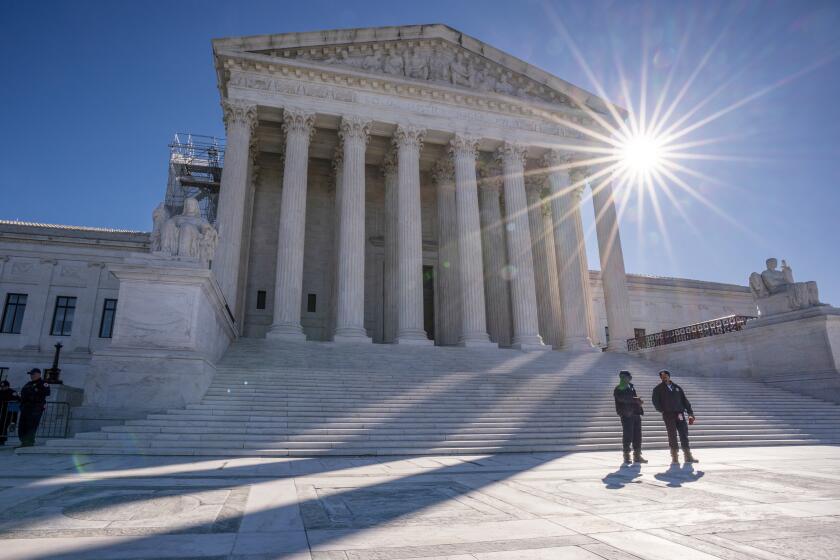Rejoicing, apprehension as three more hostages freed under Israel-Hamas cease-fire

- Share via
JERUSALEM — After the most perilous week yet for an already shaky cease-fire that has paused the calamitous Gaza war, the truce stayed on track Saturday with Hamas’ release of three Israeli hostages, one of them a U.S. citizen.
Israel, in turn, freed 369 Palestinian prisoners, its government said.
The exchange, the sixth of its kind since the accord was struck nearly a month ago, went more smoothly than some of the previous handovers.
A week earlier, Israelis were horrified and enraged by the frail, near-skeletal condition of three freed Israeli men, and by emerging testimony that hostages had suffered privation and torture under their militant captors.
This time, the three released men, civilians ranging in age from late 20s to mid-40s, appeared in much less dire physical shape — although they faced what has become a grim gauntlet that the captives are forced to endure before being handed over.
Hostages freed from Gaza confront a flood of information about loved ones and destroyed communities, figuring out their place in a changed world.
With hostages’ loved ones watching on big screens back home in Israel, the three were paraded on a stage in southern Gaza while displaying drummed-up “certificates of release” from their armed captors.
Israel, for its part, dressed freed Palestinian prisoners in white sweatshirts bearing a blue Star of David, and a notation in Arabic that their crimes would not be forgotten. Some were serving life sentences for deadly attacks against Israelis.
The trio of Israelis freed Saturday had been held for more than a year, caught up in the massive Hamas-led surprise raid of Oct. 7, 2023, whose targets included their kibbutz, a small border community called Nir Oz. More than 1,200 people were killed that day in southern Israel, and around 250 taken hostage.
Israel launched a devastating campaign of reprisal that has killed more than 48,000 Palestinians, by the count of Gaza health officials, who do not distinguish between civilians and combatants but say that the majority of the dead are women and children. Health officials say thousands also remain buried under rubble.
A Palestinian woman who lost 10 children and her husband shelters in her shattered Gaza home, where four of her youngest remain buried under rubble.
In the releases that have taken place so far — 19 Israelis and five Thai nationals under the current cease-fire, plus around 150 in a brief truce two months after the start of the war — women, children, the ill and the elderly were given priority. Most of the more than 70 still being held are male soldiers; about half are believed dead.
Up until the first appearance by the three Israelis at a site in the southern Gaza city of Khan Yunis, it was not entirely certain that Saturday’s exchange would go ahead.
After President Trump declared this month that he wanted Gaza emptied of its residents and turned into a resort-style development that the United States would “own,” the militant group threatened to put further releases on indefinite hold, citing what it said were violations of the accord by Israel.
That, in turn, drew threats from Israeli Prime Minister Benjamin Netanyahu, who said “intense” combat would resume inside Gaza if the latest releases did not go ahead. Trump upped the ante by declaring that “all hell is going to break out” if all of the remaining hostages — not only those slated to be released Saturday — were not freed.
Trump reimagines Gaza as a ‘Riviera’ without Palestinians. Israel’s Arab neighbors say no to that.
Trump then appeared to walk back that threat, at the same time taking credit for moving the deal forward.
The next phase of the accord, however, is expected to be even more fraught. With negotiations already running well behind schedule, the upcoming stage is supposed to take hold in March, encompassing the release of the remaining hostages and a permanent cease-fire.
Both are extremely difficult goals. Hamas is loath to give up the leverage of its remaining captives, Netanyahu’s hard-right political allies are clamoring to resume the war, and Trump’s proposal to depopulate Gaza has caused an uproar throughout the Arab world.
The three released Saturday were all dual nationals: Israeli American Sagui Dekel-Chen, 36; Russian Israeli Alexander Troufanov, 29; and Israeli Argentine Iair Horn, 46.
Hamas continues to free Israeli hostages in exchange for Palestinian prisoners, holding to cease-fire terms. But the militant group’s grip on Gaza remains strong
Dekel-Chen’s wife, Avital, was pregnant at the time of his abduction, and he was meeting his youngest daughter for the first time, according to family members. More commonly, though, freed captives learn of tragic developments long after the fact: Troufanov was told after his release that his father had been killed on Oct. 7, Israeli news reports said.
One of the hostages freed earlier this month, Eli Sharabi, learned only upon his release of the deaths of his wife and two daughters in the attack.
Dekel-Chen was the second American citizen to be handed over under the cease-fire’s initial phase. Hamas released another American national, Keith Siegel, on Feb. 1. At least one more living U.S. citizen is still being held, along with the bodies of four others.
More to Read
Sign up for Essential California
The most important California stories and recommendations in your inbox every morning.
You may occasionally receive promotional content from the Los Angeles Times.













